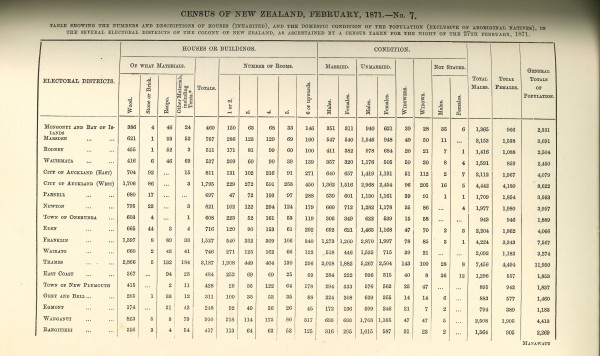Early Census Information

Our Heritage Collection includes a fascinating array of early New Zealand statistical publications, valuable tools for understanding what life was really like in the 19th century. Among these is a general summary of the 1871 Census, one of the earliest comprehensive surveys of the population, held on 27 February 1871. These early statistical reports go far beyond headcounts. Presented in a series of detailed tables, they offer insight into everyday life from population, housing, land use, and even local industry.
According to the Census, the Waikato Electoral District had a population of 3,274, including 812 males and 708 females under the age of 21. The data is broken down by province or electoral district, allowing for close comparisons across the country. One especially interesting detail is the recording of housing materials. In the Waikato district, 43 homes were built of raupoo, a native wetland plant. This traditional building material was more common in the North Island than in the South, with Thames noted as having the highest number of raupoo-constructed houses. The 1871 Census didn’t stop at population and housing. It also gathered information on land ownership and land use, including how many acres were under cultivation. The tables show how much land was sown in crops and how much livestock was held, ranging from horses, mules, and asses to cattle, sheep, pigs, goats, and poultry. There are also entries under Industry, with figures for grain and flax mills, breweries, and other manufacturing works including candle and soap making, iron and brass foundries, malt kilns, and collieries.
These documents are more than dry tables, they are a time capsule of colonial New Zealand. By comparing this early data with later censuses and statistical reports, we gain valuable insights into how New Zealand developed socially, agriculturally, and economically.
If you’re interested in exploring early statistical publications or uncovering the historical stories they tell, visit our Heritage Collection in person or get in touch with our Archives Team. We're always happy to help curious minds explore the numbers behind the past.


